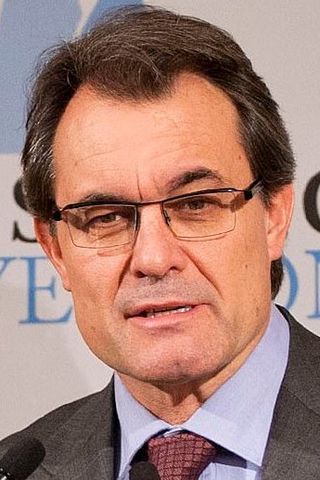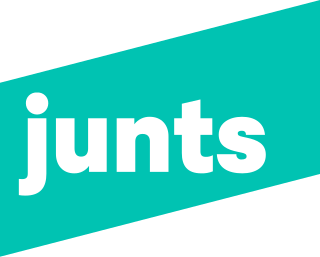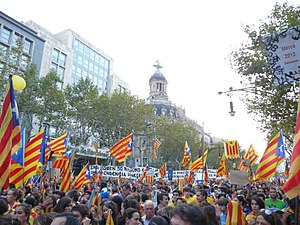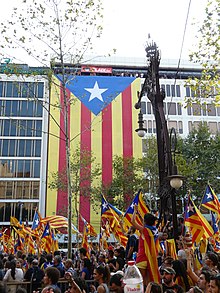
The Catalan independence movement is a social and political movement which seeks the independence of Catalonia from Spain.

The 2010 Catalan autonomy protest was a demonstration in central Barcelona on 10 July 2010 against limitations of the autonomy of Catalonia, and particularly against a recent decision of the Spanish Constitutional Court to annul or reinterpret several articles of the 2006 Statute of Autonomy of Catalonia. The number of people taking part in the demonstration was estimated at between 1.1 million and 1.5 million, while Madrid-based newspaper El País estimated the number of demonstrators at 425,000. The mobilisation was described as "unprecedented" by the mayor of Barcelona. The Barcelona daily newspaper El Periódico de Catalunya described it as "without a doubt one of the biggest protest marches that has ever occurred in Catalonia, possibly the biggest". It is thought that the 2012 Catalan independence demonstration involved more people, but this protest brought the dispute to light in the world.

Platform for Catalonia was a far-right political party rooted in Catalonia, Spain, which centred its political agenda around controlling immigration and was opposed to Catalan independence. It was strongly anti-Islamic and was widely considered a racist, xenophobic far-right political force. Its leader was Josep Anglada, town councillor in Vic.

The Assemblea Nacional Catalana is an organization that seeks the political independence of Catalonia from Spain. It also promotes the independence of other Catalan-speaking regions, which are collectively known as the Catalan Countries.

The 2012 Catalan regional election was held on Sunday, 25 November 2012, to elect the 10th Parliament of the autonomous community of Catalonia. All 135 seats in the Parliament were up for election. It was a snap election, announced on 25 September by President Artur Mas following the pro-independence demonstration in Barcelona on 11 September—the National Day of Catalonia—and the failed talks between President Mas and Prime Minister Mariano Rajoy to give greater fiscal autonomy to Catalonia.

The 2015 Catalan regional election was held on Sunday, 27 September 2015, electing the 11th Parliament of the autonomous community of Catalonia. All 135 seats in the Parliament were up for election. This was the third regional Catalan election in only five years, after the 2010 and 2012 elections and the first one in over 37 years in which Democratic Convergence of Catalonia (CDC) and Democratic Union of Catalonia (UDC) ran separately, after the dissolution of Convergence and Union (CiU) in June 2015 over disagreements on the coalition's separatist turn.

The Catalan Way, also known as the Catalan Way towards Independence, was a 400-kilometre (250 mi) human chain in support of Catalan independence from Spain. It was organized by the Assemblea Nacional Catalana (ANC) and supported by 14 nongovernmental groups. It took place in Catalonia on 11 September 2013, which is the National Day of Catalonia, known as Diada. Catalonia's Department of the Interior estimated the number of participants at about 1.6 million. The human chain followed the ancient Via Augusta, from Le Perthus up to Alcanar. According to Carme Forcadell, president of the ANC at that time, it was "a symbol of the unity of Catalan people to achieve national sovereignty".

The Catalan Way 2014, or "V", was a large gathering in Barcelona on 11 September 2014, the National Day of Catalonia, in support of the Catalan self-determination referendum of 2014 and of Catalan independence from Spain. It was organized by "Now is the Time", a unified campaign organised and funded by the Assemblea Nacional Catalana (ANC) and the Òmnium Cultural. Two massive senyeres, created by demonstrators wearing red and yellow T-shirts forming a giant human mosaic, filled the Diagonal and the Gran Via, and came together at the vortex in Plaça de les Glòries, forming a giant "V", symbolizing "victory", "vote" and "will". The "V" was 11 kilometers in length and about 200,000 square meters in area. Estimates of the attendance varied: though the Spanish government's office in Catalonia put it at about 500,000, Barcelona's Municipal Police put it at 1.8 million. An independent statistical analysis by the Autonomous University of Barcelona calculated that 900,000 people attended. The organisers, the grassroots Assemblea Nacional Catalana, said it was one of the biggest peaceful mobilizations in European history.

Junts pel Sí was a Catalan electoral, political and parliamentary alliance focused on achieving the independence of Catalonia from Spain. Established ahead of the 2015 Catalan regional election, it was formed by Democratic Convergence of Catalonia (CDC), Republican Left of Catalonia (ERC), Democrats of Catalonia (DC), Left Movement (MES) and Independence Rally (RI.cat), as well as a number of independent personalities from pro-independence sectors of civil society, including the pro-independence organizations Catalan National Assembly, Òmnium and the Association of Municipalities for Independence. The Popular Unity Candidacy (CUP) had been invited to participate in the alliance, but refused to do so and ran on its own instead, citing its disagreement with the presence of politicians in the list.
Left Movement of Catalonia is a social-democratic, pro-independence political party in Catalonia. The party was founded in November 2014 from the merger of New Catalan Left (NECat) and Catalonia Movement, which had both been formed by dissident members of the Socialists' Party of Catalonia (PSC) who were dissatisfied with what they saw as the party's lack of support for the independence movement. Its founders included Marina Geli and Ernest Maragall (NECat), but both have ever since left for other parties—Geli joined the Together for Catalonia alliance ahead of the 2017 Catalan regional election, whereas Maragall defected to Republican Left of Catalonia (ERC) in 2018.
The Catalan European Democratic Party, initially branded as the Catalan Democratic Party, was a liberal political party in Spain that supported Catalan independence. The party was founded in Barcelona on 10 July 2016 and dissolved on 28 October 2023. PDeCAT was regarded as the successor party to Democratic Convergence of Catalonia (CDC), which for most its history was a constituent party of the Convergence and Union (CiU) political formation.
An independence referendum was held on 1 October 2017 in the Spanish autonomous community of Catalonia, passed by the Parliament of Catalonia as the Law on the Referendum on Self-determination of Catalonia and called by the Generalitat de Catalunya. The referendum, known in the Spanish media by the numeronym 1-O, was declared unconstitutional on 7 September 2017 and suspended by the Constitutional Court of Spain after a request from the Spanish government, who declared it a breach of the Spanish Constitution. Additionally, in early September the High Court of Justice of Catalonia had issued orders to the police to try to prevent the illegal referendum, including the detention of various persons responsible for its preparation. Due to alleged irregularities during the voting process, as well as the use of force by the National Police Corps and Civil Guard, international observers invited by the Generalitat declared that the referendum failed to meet the minimum international standards for elections.

The Volem acollir protest was a protest march in Barcelona that took place on 18 February 2017. The purpose of the march was to demand more openness towards refugees and a more active role of the European Union in the European migrant crisis. They planned for it to be the largest protest in Europe and they achieved the goal. The size of the march was estimated at 160,000 by police and 500,000 by organisers.

National Day for Yes was a gathering in Barcelona on 11 September 2017, the National Day of Catalonia, in support of Catalan independence. It was organized by the Catalan National Assembly (ANC), the main civil society organisations behind the massive pro-independence demonstrations held since 2012.

The Operation Anubis was a police operation in Catalonia, Spain, initiated on 20 September 2017 by the Civil Guard following orders of the trial court number 13 of Barcelona, directed by judge Juan Antonio Ramírez Sunyer. Its aim was to dismantle the framework of the Catalan independence referendum of 1 October 2017, that was suspended on 6 September 2017 by the Constitutional Court of Spain as breaching the 1978 Constitution. Different headquarters of the Generalitat de Catalunya were searched and 14 people were arrested, including high ranking administrative staff, and company CEO's involved in the preparation of the referendum. Simultaneously, several printing and media companies were searched looking for ballot papers and boxes. More than 140 websites were shut down by the Spanish justice and police.

Societat Civil Catalana is a Spanish unionist organization based in Barcelona. Launched in 2014, SCC seek to counter the Catalan independence movement.

Together for Catalonia was an electoral and parliamentary alliance in Catalonia, registered as a political party in the interior ministry in July 2018, originally envisaged as a platform comprising the Catalan European Democratic Party (PDeCAT), successor of the late Democratic Convergence of Catalonia (CDC), and independents and centered around the candidacy of former Catalan president Carles Puigdemont ahead of the 2017 Catalan regional election. Some of these independents went on to form the Action for the Republic (AxR) political party, which is also part of the alliance in the Parliament of Catalonia.

Tabarnia is a fictional region within Catalonia, a satirical parody of the Catalan independence movement and a movement against the independence of Catalonia from Spain. The Tabarnia movement mirrors the independentist movement advocating for a referendum to create a new Spanish autonomous community out of coastal urban parts of Catalonia, a region that gathers most of the population of Catalonia and in which, in general, votes for independentist parties rarely reach 30% of the votes but generates most of the gross domestic product of Catalonia. It would encompass the current Catalan comarques of Maresme, Baix Camp, Baix Penedès, Alt Penedès, Garraf, Baix Llobregat, Barcelonès, Vallès Oriental, Vallès Occidental and Tarragonés.

Together for Catalonia is a Catalan political party established in July 2020 by former Catalan president Carles Puigdemont, announced on 2 July as a result of the foundering of negotiations with the Catalan European Democratic Party (PDeCAT) over the re-organization of the post-convergent political space under the "Together for Catalonia" umbrella. The party's founding congress took place between 25 July and 3 October, after being launched on 18 July with the public presentation of its imagery and corporate identity by Elsa Artadi and Marta Madrenas.

The 2017 demonstration against Catalan independence was a large demonstration in Barcelona, Spain, organized by Societat Civil Catalana on 8 October 2017, usually named after its slogan 'Stop! let's come to our senses'. It took place around midday starting in Plaça Urquinaona and ending in França railway station. The objective of the rally was to voice protests and growing concerns about the accelerating Catalan independence movement and the recent referendum on self-determination as well as to call for the preserved unity of Spain. The number of demonstrators was estimated at 950,000 by the organizers and 350.000 by the local police.
























